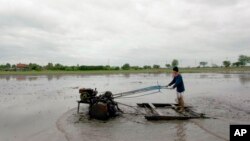Scientists have identified a gene that helps rice plants produce grain even during drought conditions.
The gene is the blueprint for a protein that makes the plant’s root tips more responsive to the pull of gravity.
Rice plants with the gene send their roots deeper into the soil than those without it. They can access water farther underground.
The gene is called DRO1, short for “deeper rooting.”
The Japanese researchers found that, under moderate drought conditions, plants without DRO1 produced 60 percent less rice than normal. But plants with the gene were virtually unaffected.
“This group of authors has identified a gene that seems to be of pretty significant importance,” said Julia Bailey-Serres, a rice researcher at the University of California-Riverside, who was not involved in the study.
Under severe drought conditions that cut rice production to near zero in plants without the gene, the DRO1 plants still managed to produce some grain.
“There was only 30 percent grain yield in this new rice variety under that condition, but still, comparing zero to 30 is quite a significant insurance policy for the farmer,” said Bailey-Serres.
She added that it would take only a few years to introduce this gene to shallow-rooting rice varieities around the world.
Rice is a staple crop for roughly half the world’s population, and climate change is expected to pose challenges to crop production.
The Japanese researchers say other crops, such as maize, have genes similar to DRO1, which may prove useful in adapting them to drought conditions as well.
The gene is the blueprint for a protein that makes the plant’s root tips more responsive to the pull of gravity.
Rice plants with the gene send their roots deeper into the soil than those without it. They can access water farther underground.
The gene is called DRO1, short for “deeper rooting.”
The Japanese researchers found that, under moderate drought conditions, plants without DRO1 produced 60 percent less rice than normal. But plants with the gene were virtually unaffected.
“This group of authors has identified a gene that seems to be of pretty significant importance,” said Julia Bailey-Serres, a rice researcher at the University of California-Riverside, who was not involved in the study.
Under severe drought conditions that cut rice production to near zero in plants without the gene, the DRO1 plants still managed to produce some grain.
“There was only 30 percent grain yield in this new rice variety under that condition, but still, comparing zero to 30 is quite a significant insurance policy for the farmer,” said Bailey-Serres.
She added that it would take only a few years to introduce this gene to shallow-rooting rice varieities around the world.
Rice is a staple crop for roughly half the world’s population, and climate change is expected to pose challenges to crop production.
The Japanese researchers say other crops, such as maize, have genes similar to DRO1, which may prove useful in adapting them to drought conditions as well.







